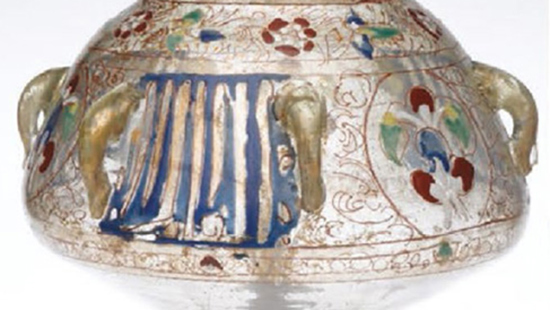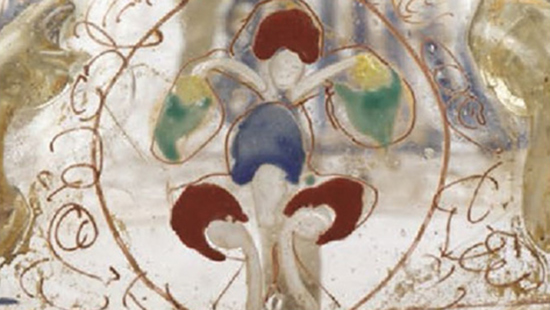About This Project
The Center for Scientific Studies in the Arts investigated the origin and production of an enamel mosque lamp in the collection of the Brooklyn Museum. The lamp has a flared neck, a globular body, six suspensions loops at its shoulder, and a splayed foot that has been attached to the body. All of these components were made from clear blown glass decorated with multicolored enamels and gilding. Enameled glass mosque lamps were originally produced in Egypt and greater Syria during the Ayyubid (c. 1171-1260 CE) and Mamluk (c. 1250-1517 CE) periods. However, this style of lamp was also reproduced in the 19th century to satisfy European collectors’ new tastes for “Islamic” art.
The Investigation

The Process
In this project, we used a combination of analytical techniques, including in-situ X-ray fluorescence analysis (XRF), Raman spectroscopy, and Scanning Electron Microscopy with Energy Dispersive X-ray Spectroscopy (SEM-EDS) to characterize the materials, their microstructure, and composition. Learn more about the tools and techniques used.

The Impact
This lamp from the Brooklyn Museum collection presented an interesting case study since scholars of Islamic art have suggested it has formal characteristics that could support either a Medieval or 19th-century attribution. From the data gathered, we assessed the manufacturing sequence of the different parts composing the glass mosque lamp and suggested a period for its production. This, in turn, allowed us to make recommendations regarding the conservation of this artifact.
The Investigation Outcome
The lamp’s body, handles, and wick-holder were produced using the same type of glass, one likely incorporating a plant ash flux typical of medieval Islamic glass. Materials composing the body’s enamel decorations are consistent with Mamluk production. The foot’s distinct composition indicates that it is a later addition to the object. Combining the analytical, stylistic, and historical pieces of evidence, this glass lamp was identified as a Mamluk example, one of few comprising an integral wick-holder.
Learn More
Learn about the methodology of this investigation and the tools and techniques used in order for the results not only to authenticate this artifact but also to make informed decisions regarding its conservation.
Read the Project Publication

